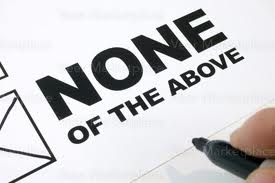There is no religious group in the U.S. that places itself halfway between the political parties.
Instead, every religious tradition has a “baked-in” political preference now.
Nones favor Democrats. Christians (by and large) favor the GOP. @RNS https://t.co/3LSJ1smBE1
— Ryan Burge 📊 (@ryanburge) August 10, 2019
I am so, so sorry to repeat a story that will be oh-so familiar to longtime GetReligion readers. Honest, I apologize in advance.
But sometimes you just have to do what you have to do. The subject material requires it.
In a way, that’s the Big Idea at the center of this week’s “Crossroads” podcast (click here to tune that in) which returns to one of the biggest religion stories of the late 20th and early 21st centuries — the rise of all of those religiously unaffiliated Americans that headline writers like to call the “Nones.”
That’s a religion story. No doubt about it.
But it has political implications. No doubt about it.
Why is that? Because sometimes ancient religious beliefs have strong political implications in the modern public square.
So where are we going to start, once again? Set the the WABAC Machine for the summer of 2008, when a circle of journalists — mostly from Africa and Asia — met in the old Washington Journalism Center seminar room to discuss how religion and politics collide in modern America. The speaker was scholar-pollster John C. Green of the University of Akron and, at that time, the Pew Researcher Center. The line-graph that he drew on the whiteboard that day was packed with insights that would show up in the seismic 2012 Pew study on the rapid rise of the “Nones.”
As I wrote, several years ago here at GetReligion:
On the right side of the American religious marketplace, defined in terms of doctrine and practice, is a camp of roughly 20 percent (maybe less) of believers who are seriously trying to practice their chosen faith at the level of daily life, said Green. Then, on the other end of the spectrum, there is a growing camp of people who are atheists, agnostics or vaguely spiritual believers who define their beliefs primarily in terms of the old doctrines that they no longer believe. This is especially true when it comes to issues of salvation and sex. As the old saying goes, on these issues these spiritual-but-not-religious believers reject all absolute truths except the statement that there are no absolute truths.
This is a natural home for large numbers of the religiously unaffiliated, especially the young. This growing camp on the cultural left also includes many Catholic liberals, liberal Jews and the lots of pastors and activists from America’s shrinking, aging, but still important, mainline religious flocks (the “seven sisters” of liberal Protestantism). That is now something like 25 percent or more of postmodern America.
When the 2012 “Nones” study came out, here is what I wrote at the end of an “On Religion” column on this topic:
The unaffiliated overwhelmingly reject ancient doctrines on sexuality with 73 percent backing same-sex marriage and 72 percent saying abortion should be legal in all, or most, cases. Thus, the “Nones” skew heavily Democratic as voters – with 75 percent supporting Barack Obama in 2008. The unaffiliated are now a stronger presence in the Democratic Party than African-American Protestants, white mainline Protestants or white Catholics.
“It may very well be that in the future the unaffiliated vote will be as important to the Democrats as the traditionally religious are to the Republican Party,” said Green, addressing the religion reporters. “If these trends continue, we are likely to see even sharper divisions between the political parties.”
As I worked on a related column this week, I shot Green a quick email to see if his views have changed in any way. I also sent him a link to some relevant 2018 General Social Survey numbers put together (and shared on Twitter) by political scientist Ryan P. Burge of Eastern Illinois University, the co-founder of the must-bookmark Religion In Public blog.
Green quickly wrote me back, stating that his 2012 statements remain in place: “My views have not changed.”
So why talk about this now? My “On Religion” column this week focused on the big two religion-beat statistics that have dominated chattering class discussion in recent years — the 81 percent white-evangelical vote for Donald Trump in 2016 and the “Nones” numbers, which have continued to rise.
However, there is another number that is crucial in the equations that emerge from Green, Burge, Pew Resarch and others. That would be the stunning demographic implosion of the old world of “mainline” Protestantism (the Seven Sisters) — the loss of 30-50 percent of the membership rolls since 1960.
Why does this matter? Here is a key chunk of my column:
“Mainline is a tradition that has declined rapidly over the last 40 years, while Nones have risen just as dramatically,” tweeted Burge. “It seems that a lot of kids who were raised mainline left religion entirely – their parents stayed. But, that means mainlines are going to face an age cliff soon.”
With that in mind, it’s hard not to connect the aging mainline numbers with the rising tide of the “religiously unaffiliated.” In the 2018 GSS, Burge tweeted, “33.8% of those under 35 are Nones, compared to 11.5% of those over 65.”
This raises a question that has baffled researchers, he noted. If America is moving left on many moral issues, why have progressive churches declined so sharply, losing between 30-50% of their members since the 1960s?
“That’s the question of the year, and that’s been true for many years now,” said Burge, who was raised Southern Baptist but is now active in the mainline American Baptist Church USA. “People are either being intentionally and intensely religious – like really active evangelicals, or conservative Catholics, or yada yada – or they’re leaving the more moderate churches that we’ve always seen as holding down the middle of religious life in this country,” he said.
“We’ve ended up with two trends that appear to be related. We’re losing moderation in the political space in American life, and we’re losing moderation in the religious space, as well.”
Wait for it. Here is one other key quote that we discussed this week:
Burge put it this way on Twitter, describing how doctrines can affect public life: “There is no religious group in the U.S. that places itself halfway between the political parties. Instead, every religious tradition has a ‘baked-in’ political preference now. Nones favor Democrats. Christians (by and large) favor the GOP.”
That’s a strong statement, but one compatible with the chart that Green drew on that DC whiteboard in 2008. Like I said earlier, ancient doctrines have modern implications that are hard to shake.










